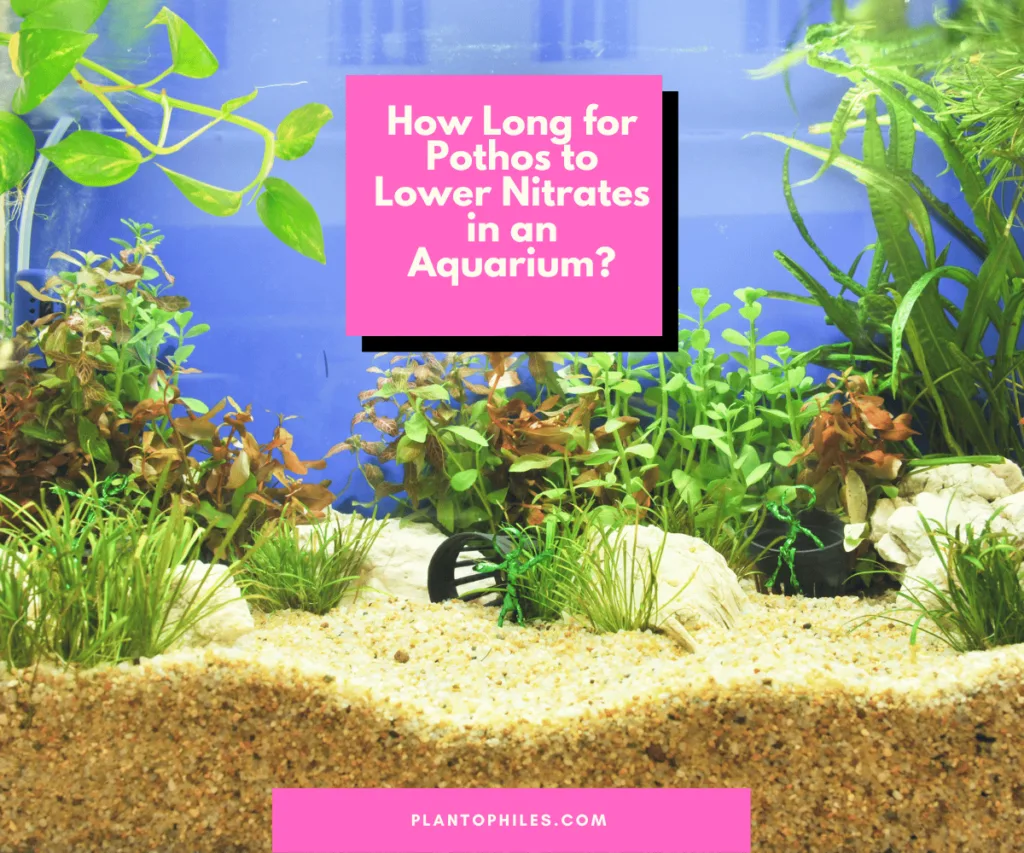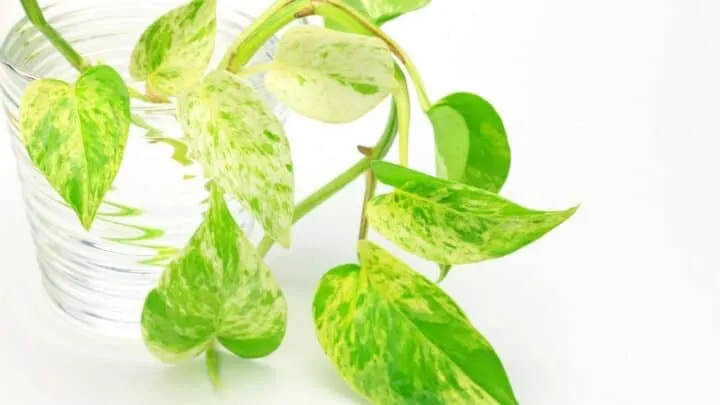Pothos can be used in an aquarium to lower nitrates. Epipremnum aureum, or Pothos, is a very popular and easy-to-grow houseplant.
This plant is considered a good cleaner because it removes toxic chemicals from indoor air. The Pothos plant is often used in hydroponic systems and bioactive terrariums.
Due to its purifying qualities, Pothos is often planted in aquariums. It will do wonders in your aquarium by lowering the nitrate level.
Table of Contents
How Long for Pothos to Lower Nitrates in an Aquarium?
Pothos will absorb nitrate and other nutrients through its roots within 4 to 5 days. Since Pothos are fast-growing plants and need nitrate at a faster rate, they will absorb it at a much faster pace as compared to other aquatic plants.

Lowering of Nitrates in the Aquarium by Pothos
Nitrate is produced in every aquarium’s ecosystem through fish and other products. As nitrate is toxic to the fishes, it is essential to eliminate it from water.
One method of doing this is to change the water regularly.
Nevertheless, installing aquatic plants in your aquarium is another way of doing this. In this regard, Pothos is the top choice of fish owners.
Like any other aquatic plant, Pothos will lower nitrate levels but much faster than other plants.
Pothos Plant for Aquarium
Pothos plants are fast-growing houseplants. Therefore, they require nutrients faster.
Pothos will absorb the nitrate from your aquarium rapidly, more precisely, in 4 to 5 days.
Pothos surely is a good choice to lower nitrate levels fast and cheaply.
A 20-40 ppm reduction in nitrate levels in the aquarium is feasible.
How to Install a Pothos in Aquarium
You can buy a Pothos from your local nursery or take one from your garden if you have any. You do not need very big Pothos plant since they develop very rapidly.
You can use a single-leafed Pothos, place it into the aquarium, and it will instantly grow its roots. However, using a Pothos with an established root system is recommended.
Thoroughly wash the roots to make sure it does not contain any soil. If left unwashed and installed, it will cause a problem in the water’s chemical balance.
If you have fishes that nibble on plants, install your Pothos in the ‘hang at the back filter; this will keep your fishes safe.
Putting the Pothos in an area away from the filter’s motor is recommended. This is to keep the filter safe from clogging due to the rapid expansion of the roots.
Whereas if you think your fish will not invade the Pothos, you can install it directly into the tank.
For this purpose, submerge them into the tank while ensuring the leaves are above the water level. The lid of the aquarium will provide support to the plant and hold it in place.
Sooner or later, the Pothos will develop into a huge vine that can be guided to climb up the wall. The long stringy roots of this plant will create beautiful scenery.
You can easily cut away some of the leaves if it outgrows the area and uses them to propagate in other tanks.
The best factor is that Pothos is the cheapest way to keep the algae and nitrate levels in the aquarium very low.
How to Cut Pothos for Aquarium
Pothos will add beauty to your aquarium if placed properly. If you want to propagate the plant, learn the right way to do this.
For the cutting process, locate the nodes of the Pothos.
When you have located the node, cut an inch below the node using a sharpie. The angle at which you cut also needs to be precisely 45 degrees.
The plant will start growing from the nodes. Place the cutting in a small jar with water and allow it to develop before putting it into the aquarium.
How to Care for the Pothos in the Aquarium
Below is a care guide for after you have put the Pothos in the aquarium:
Temperature
Since the Pothos plant is tropical, it will thrive in a wide range of temperatures.
However, an ideal environment would be where the temperature is between 75 to 80 degrees Fahrenheit (23.9 to 26 degrees Celsius).
Light
Fish tanks and Pothos are known for surviving in low light with very little exposure to direct sun.
Pothos will do just fine under dim lights but remember. Some varieties lose their green color because of the low sun exposure.
Water and Fertilizer
The temperature of the aquarium water will work fine for the healthy growth of Pothos. Water with a lot of fish will provide the necessary nutrients like nitrates and ammonia.
Pothos in tanks that do not have a lot of fish might suffer from malnutrition. So to overcome this, you can put in some liquid fertilizer made for aquariums.
The common Pothos varieties that the fish owners love include:
- Golden Pothos
- Peral and Jade Pothos
- Neon Pothos
- Cebu Blue Pothos
- Manjula Pothos
Frequently Asked Questions
Is Pothos in aquariums safe for fish?
It is safe to install Pothos in your aquariums. However, avoid adding direct leaf cuttings in the tank and rather allow the cuttings to grow separately. Then, add it to your tank after it has rooted, leaving the leaves and stems above the water level.
Why does nitrate level increase in water?
Nitrate is a waste product the fishes produce in a healthy aquarium ecosystem. It is something very harmful to the fish and might cause nitrate shock and death. If the water is not cleaned regularly, nitrates keep increasing, harming the fish.
Takeaways
- Pothos can grow in aquariums indefinitely as long as there are sufficient nutrients
- Pothos can reduce the nitrates in an aquarium
- It takes 4-5 days to see the results

Daniel has been a plant enthusiast for over 20 years. He owns hundreds of houseplants and prepares for the chili growing seasons yearly with great anticipation. His favorite plants are plant species in the Araceae family, such as Monstera, Philodendron, and Anthurium. He also loves gardening and is growing hot peppers, tomatoes, and many more vegetables.


